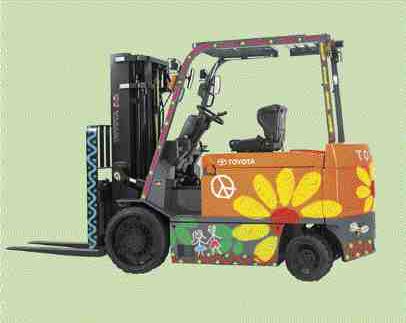
Lift trucks are designed to lift materials while stationary or to move materials while driving forward. They are well-designed for moving and lifting materials quickly in tight corners and small space…
Lift trucks are designed to lift materials while stationary or to move materials while driving forward. They are well-designed for moving and lifting materials quickly in tight corners and small spaces. Like everything else, the technology of forklifts has evolved. No longer are seatbelts the major safety feature of these machines. Today, product designers and manufacturers released several models with better designs and major safety enhancements.
Latest built-in safety features
Toyota Industrial Equipment has developed System of Active Stability (SAS) technology, that helps reduce the risk of tip-overs and spilled loads by increasing the stability of truck through the Active Control Rear Stabilizer and an Active Mast Function Controller. Through several sensors strategically placed on the lift trucks, SAS can monitor and control its movements.
“SAS was designed to remove operator errors. It’s like the Automatic Brake System on cars — it’s there when you need it,” said Keith De Bruin of Toyota Canada Inc., Toronto, ON. “It doesn’t guarantee that there will be no accident, but it certainly helps you to prevent it from happening.”
The way SAS works is simple: when it senses instability, the swing lock cylinder, located below the counterweight, engages and locks the rear axle to reduce the risk of tip-over. Also, depending on the height and weight of the load, the forward tilt angle controller automatically overrides the operator’s manual control and limits the forward tilt angle of the mast, making it more difficult for a load to spill.
As a folio finisher for Weyerhaeuser, Donna Skotheim has one advice for lift truck manufacturers: pay attention to the ergonomics of lift trucks.
“There should be more options for the operators in adjusting the seat and other controls,” she explained. “There is not much leeway for operators who are very small or very large, or those with longer legs.”
So another household name in forklifts is doing just that. Hyster Company has put emphasis on the comfort of forklift operators. The company’s engineers decided to improve the ergonomics of their machines since, for them, the more comfortable the drivers are, the less likely that they will commit errors in operating the machine. Good ergonomics means better concentration and good operation as well.
For example, the hydraulic controls have been moved from the dash to the right hand side of the seat next to a padded armrest. This eliminates the long reach and excessive motion associated with cowl-mounted levers. There is also the new full-suspension seat, which absorbs the frequent impact and vibration that forklift operators endure on a daily basis.
Better view is always better
Pat Freeborn’s 15 years of experience at Weyerhaeuser has taught him a lesson that he wants to pass to forklift manufacturers: better view is always better.
Hyster maintained the all around visibility design of their trucks with the VISTA mast. “Better vision is what gives drivers greater operating confidence and control,” said Scott Alexander of Hyster’s marketing division.
Brakes were given their due as well. “Today’s operators are carrying heavier loads, which require heavy-duty brakes,” said Alexander. In fact, a two-pedal brake option is available on their new XM series.
European manufacturer, Kalmar, has released its newest trucks designed with intelligent automation.
Kalmar’s designers gave emphasis to operator environment with its spacious cab and step-less forward and reverse operation to assure maximum driving accuracy. One feature is the sloping top window that reduces the risk of reflection. The adjustable steering wheel and variable seat settings make it easy to find the working position that the driver is most comfortable with. To help the operator even more, the unit’s status is clearly displayed by lamps in the operator’s field of vision.
The engine provides the right amount of power for each maneuver, regardless of throttle or whether the operator is performing several tasks at the same time. With lift, rotate and clamp levers, the operator controls each function individually. The automated system also makes it impossible to open the gripping unit during off-ground handling. This means the operator cannot release the reel by accidentally operating the lever.
Speed, a contributing factor in accidents, was given attention as well with the hydrostatic operation that enables speed control in forward and reverse gears. Engine brake can be adjusted in nine levels, from minimum to maximum braking.
How efficient?
Although changes were made to make the forklifts less of a hazard, efficiency was not compromised in any way. With the improvement in safety came the improvement in productivity.
Most forklifts now are maintenance-free and offer James Bond-like technology that prevents damage to the load.
Take Kalmar forklifts for example — with a simple push of a button on the tilt lever, the operator can be sure that the machine will keep the reel vertical. This reduces the risk of edge damage when the reel is set down onto the ground, truck deck, or on top of another reel.
Better results
It is to the industry’s advantage that forklift manufacturers pay attention to careful paper handling. Nowadays, it is almost the standard for lift trucks to provide correct clamp pressure and angle, as well as protection against chain slackness to prevent paper roll damage.
There is still a lot of room for improvements and, according to Stuart Sandberg, trainer at Weyerhaeuser, manufacturers must get their acts together in standardizing the lift trucks.
“The arrangements of hydraulic controls must be standard for all lift trucks,” he said. “It is confusing to find a brand that has their hydraulic controls at the back, and the next day you find another manufacturer that has it on the side or up front.”
Certainly, the industry can use better productivity and less accident in mills.
Print this page
